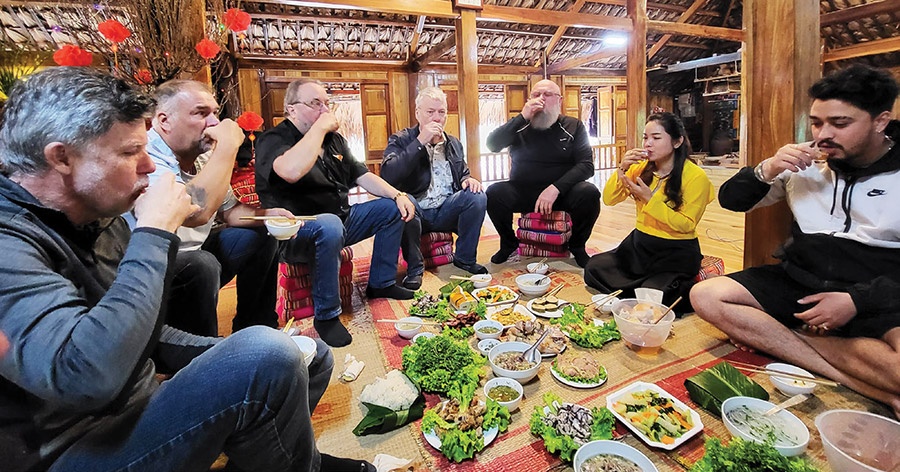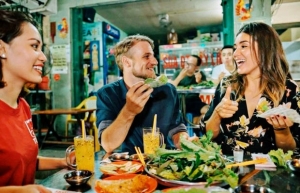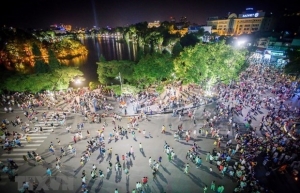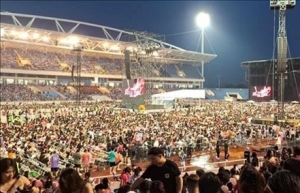Attracting international visitors via Vietnamese dishes
During a business trip to Vietnam at the end of July to attend the “Taste of Japan” event, Tomisawa Hirokazu, Goodwill Ambassador of Japanese Cuisine, gave many compliments to the local dishes he had experienced.
“I have had the opportunity to enjoy many Vietnamese dishes and they are very delicious, suitable for many Japanese people and diners from other countries. I believe anyone who has ever tried Vietnamese food will like it and want to travel here,” he said at the event.
Hirokazu is also president of the Tokyo Chefs Association and has made many contributions to promoting Japanese culinary culture abroad, contributing to spreading and attracting more tourists to the land of the rising sun.
“Traditional Japanese cuisine has become increasingly popular since it was recognised by UNESCO as an intangible cultural heritage 10 years ago,” he said. “Vietnam should take advantage of such opportunities to promote and use cuisine effectively to promote the tourism industry.”
 |
| Attracting international visitors via Vietnamese dishes |
Taking full advantage
Attracting international visitors through the stomach has long been a strategy of the Vietnamese tourism industry. The country set itself the goal of becoming the kitchen of the world many years ago and possesses many advantages to be able to make it a reality.
The dream was given a major boost in June when 70 restaurants and eateries in Vietnam were listed in Michelin Selected by Michelin Guide, of which four restaurants in Hanoi and Ho Chi Minh City were given stars.
The presence of any restaurant on such a list provides compelling benefits not only to the eatery being honoured, but also to the tourism industry of that country as a whole.
“Michelin-branded restaurants have played a role in attracting visitors. According to proven statistics, each restaurant in the world receiving one Michelin star will increase revenue by 10-20 per cent. If receiving 2 stars, it will increase 30-40 per cent in revenue, and three stars will operate at maximum capacity,” said Nguyen Trung Khanh, chairman of the National Authority of Tourism.
Vietnamese cuisine has also been named many times on global tourism rankings in recent times.
In early 2023, Travel & Leisure Magazine ranked Vietnam on the list of the most attractive culinary destinations in Asia. At the same time, Vietnam also ranked 20th in the top 95 most attractive cuisines in the world by the world food map TasteAtlas.
The World Travel Awards 2020 also named Vietnam Asia’s leading culinary destination. The Telegraph ranked Hanoi second out of 18 cities with the most attractive cuisine, while a CNN travel column rated Ho Chi Minh City as Vietnam’s culinary capital, as one of 23 cities with the world’s most impressive street food.
Of the three common Vietnamese words or phrases included in the Oxford English Dictionary, two are derived from food – “pho” and “banh mi”. In addition to famous dishes such as pho, bun cha, and spring rolls, Vietnam also possesses many attractive local dishes thanks to the diversity of geography, climate and culture among regions – an advantage that is not always widely known.
Therefore, after years of struggling to develop culinary tourism, the entry of the Michelin Guide is expected to become a launching pad to bring Vietnamese cuisine closer to the world and make a strong contribution to attracting international tourists, just like its effect on the industry in Thailand.
According to figures from the Tourism Authority of Thailand in 2022, the Michelin Guide boosted tourist spending there by 10 per cent annually since it launched five years ago. The industry currently accounts for about 18 per cent of Thailand’s GDP, of which the contribution from food-related businesses accounts for one-fifth of total revenues.
Building a culinary map
According to the World Food Tourism Association, more than 80 per cent of international visitors have a need to learn about local cuisine at the destination. Around 25-35 per cent of the travel budget is spent on food and beverage expenses during their trip.
However, not all countries can exploit this gold mine well without a proper strategy, besides the usual promotion and advertising programmes.
Dinh Minh, chairman of the board at the Seafood World restaurant chain, with nearly 20 years of experience in the culinary business, said that the problem for Vietnamese cuisine lies in impromptu development.
“The culinary industry lacks investment from big businesses, while the business of Vietnamese people living in the country and abroad is typically spontaneous and individual,” Minh said.
Minh added that Vietnam needs to build a culinary tourism map. “In order to do this, it requires the support of large businesses, starting from choosing the right menu, training human resources in both cooking skills and culinary culture, then bringing them to other countries to work to promote Vietnamese cuisine,” he suggested.
According to Nguyen Quoc Ky, chairman of the Vietnam Culinary Culture Association, programmes and products introduced to domestic and international tourists help them discover local cuisine, or even get involved in cooking classes during tours.
“However, in order to bring cuisine to the world and promote tourism, it is necessary to change the method of promotion and have a clearer orientation from state management agencies so that culinary culture really becomes a national brand,” Ky said.
One such initiative for promotion began a month ago when the National Tourism Administration signed a contract with Nestlé Vietnam to jointly build a digital map of culinary tourism and promote local cuisine. More than 6,000 recipes have been shared by locals on the platform in the time since.
Le Bui Thi Mai Uyen, head of the Food Division at Nestlé Vietnam, said after the map is completed with about 50,000 recipes, it will be integrated into digital platforms to suggest places to eat and drink that foreign visitors should try when coming to Vietnam.
“The project will contribute to spreading Vietnamese cuisine more widely. International tourists can not only experience delicious food when travelling to Vietnam, but also can use these recipes to cook for their relatives and friends to enjoy when returning home,” Uyen said.
 | Culinary tourism to become national strategic product Vietnam has planned to develop culinary tourism into a national strategic product, contributing to improving the competitiveness and brand of Vietnam's tourism. |
 | Hanoi develops night-time tourism to attract more visitors Hanoi's Department of Tourism plans to organise a series of night-time tourism activities to tap the potential of the night-time economy and attract more visitors to the capital city. |
 | Over 3,000 int'l visitors come to Hanoi for BlackPink concert The Hanoi Department of Tourism on August 5 announced that out of 70,000 peopple flocking to Korean girl band Blackpink’s concert at the Hanoi-based My Dinh National Stadium on July 29 and 30, over 3,000 ones are international visitors. |
What the stars mean:
★ Poor ★ ★ Promising ★★★ Good ★★★★ Very good ★★★★★ Exceptional
Related Contents
Latest News
More News
- The destinations powering Vietnam’s festive season travel demand (December 04, 2025 | 18:33)
- Vietnam named among the world’s most exciting winter destinations (December 04, 2025 | 15:10)
- Phu Tho emerges as northern Vietnam’s new tourism hub (December 01, 2025 | 17:00)
- Vietjet completes Airbus A320/A321 updates ahead of deadline (December 01, 2025 | 09:49)
- Vietjet resumes Con Dao flights from early December (November 28, 2025 | 15:24)
- Free tickets, Lunar New Year promotions on offer at Vietjet Mega Livestream (November 26, 2025 | 15:32)
- Scandinavian Airlines and Vietnam Airlines broaden agreement with new routes (November 25, 2025 | 17:04)
- Halong Cruise Port welcomes over 3,100 international visitors (November 12, 2025 | 18:06)
- Vietnam.travel climbs to second place in Southeast Asia website rankings (November 12, 2025 | 18:01)
- Cat Ba named among Southeast Asia’s top island adventures (November 11, 2025 | 18:09)

 Tag:
Tag:





















 Mobile Version
Mobile Version